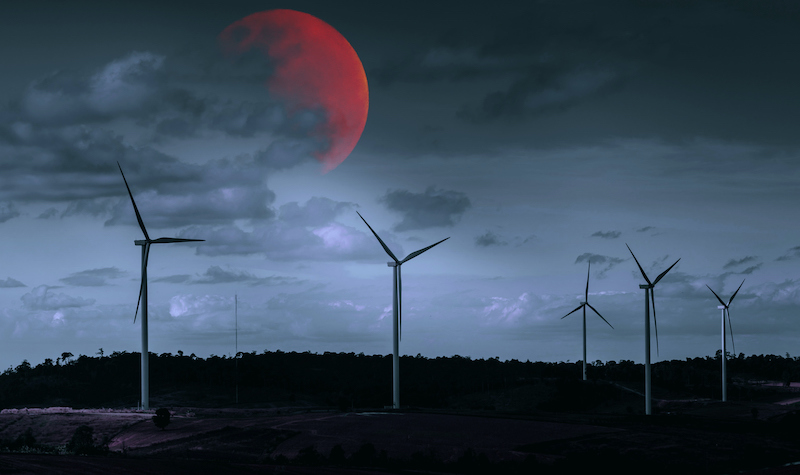
Scholar argues that energy regulations that once protected consumers now block renewable energy companies.
One unexpected obstacle in the United States’ transition to clean energy: zombies.
Zombie energy laws prevent utilities from shifting to renewable energy, according to a recent article by University of Chicago Law School professor Joshua C. Macey. A century ago, these laws protected consumers against electric utilities. But now, Macey argues, the same laws shelter fossil fuel generators from competitive forces and frustrate wind and solar generators’ efforts to join the energy market.
In the early 20th century, the U.S. government gave electric utilities a legal right to monopoly power. Regulators thought that electricity costs would be lowest if one utility met all energy demands in each regional market. But monopolies also have the power to abuse “captive ratepayers” with high rates and poor service.
Historically, policymakers responded to this concern with protective rate regulations. Utilities could only operate if they charged electricity rates established by a federal administrator during a ratemaking proceeding. Prior to building new transmission lines or facilities, utilities had to obtain “certificates of public convenience and necessity,” which reflected regulators’ assessment that the expansion was “in the public interest,” financially viable, and met actual consumer demand. Thanks to a series of U.S. Supreme Court cases, utilities also enjoyed protection from antitrust lawsuits if they charged the rates approved by a regulatory agency.
By the 1970s, though, policymakers moved to deregulate the energy sector, under the theory that increasing competition would drive down consumer costs. The Public Utility Regulatory Policies Act of 1978 required vertically integrated utilities—which own both energy generation and transmission services—to purchase energy from other power plants and to allow those plants to connect to their energy transmission grid. The Energy Policy Act of 1992 increased the number of facilities allowed to generate and sell electricity to distributors and did not require these newcomers to engage in ratemaking proceedings. In the 1990s, the Federal Energy Regulation Commission (FERC) sought to increase competition by ordering utilities to “unbundle” their transmission and generation services and by creating a bidding system that picks the cheapest available generators at any moment to provide electricity to the grid.
As a result, most U.S. regulators have abandoned ratemaking proceedings, relying instead on competitive forces within the bidding system to keep electricity rates low. But Macey claims that vertically integrated utilities still exploit the older laws from the rate regulation era. Although FERC commanded utilities to unbundle their generation and transmission services, zombie energy laws’ pro-monopoly bias enabled utilities to avoid divesting themselves fully of their generation assets. These laws motivate vertically integrated utilities, including many coal companies, routinely to submit low bids. Low bids ensure that generators owned by the utility are first in line to send electricity to the grid, but they do not reflect the true cost of a utility’s energy production.
Consistently submitting low bids depresses the market clearing price, which is paid to every generator that provides energy to the market. But Macey claims that nuclear and coal generators can remain unaffected by their own price distortions, because state regulators persist in allowing vertically integrated utilities to recoup their losses from ratepayers. Macey argues that this increases consumer prices. He points to research indicating that coal-fired generators owned by vertically integrated utilities cost ratepayers an excess of $3.5 billion between 2015 and 2017.
Predatory rate distortions, and the zombie laws that enable vertically integrated coal companies to engage in them, harm the growth of renewable energy. Wind and solar companies rely on clearing the energy bidding floor to recover the price paid to generators. When underbid by a coal company, the renewable energy companies are less likely to clear the auction—and if they do, they receive a lower payoff than if the coal company were barred from underbidding. Renewable energy companies also struggle to contest these price distortions in court, as protections against antitrust lawsuits that once applied to electricity monopolies still apply to the restructured energy market.
Macey also argues that the same certificates of public convenience and necessity that once protected consumers now benefit entrenched fossil fuel generators, “raise electricity prices, and reduce competition.” State laws still require companies to receive these certificates before building new infrastructure, but state utility commissions often deny renewable energy companies certificates.
For example, utility commissions in three states denied certification to one wind energy company. In 2011, a fossil fuel utility convinced the Arkansas Public Service Commission to deny certification because the wind company had no existing transmission infrastructure, and so did not fit the legal definition of a “utility.” In 2017, the Illinois Supreme Court denied certification for the same reason. The Missouri Public Service Commission claimed that certification was not in the public interest because “harm” to landowners “outweighed any in-state benefits.” Projections for the wind project, however, suggested that it would create over 1,500 jobs and reduce electricity prices for Missourians by over $10 million annually.
How should zombie energy laws be laid to rest? To address their effects, Macey calls on FERC to interpret the Federal Power Act as prohibiting the market distortions that coal companies use to prop up a dying coal sector.
FERC is responsible, after all, for ensuring that wholesale electricity rates are “just and reasonable” and not “unduly discriminatory.” Macey further argues that since FERC holds exclusive jurisdiction over energy transmission lines, it should encourage state regulators to be more permissive in granting certifications of public convenience and necessity. He contends that since many generators no longer file rates with regulatory agencies, courts should also no longer allow utilities to escape civil antitrust lawsuits.
Ultimately, Macey urges Congress and state governments to adopt legislation that updates energy law and creates a level playing field for renewable energy generators seeking to build infrastructure and compete in the marketplace. Only by driving a legislative stake through the heart of zombie energy laws will the United States be able to make the rapid and smooth transition to renewable energy, writes Macey.



